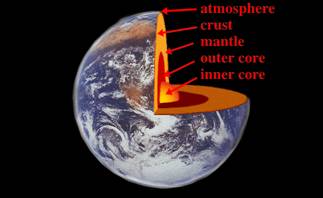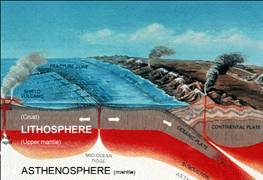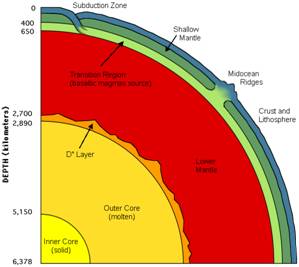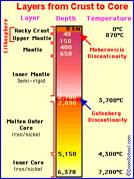Hadiths Prove Islam

Description of Seven Earths
From these miracles is the “seven” earths, mentioned by the Prophet in several of his sayings. From them are the following two: |
|
Hadeeth 1 It was narrated on the authority of Abu Salamah that a dispute arose between him and some other people (about a piece of land). Hadith 2 Salim narrated on the authority of his father that the Prophet said:“Whoever takes a piece of land of others unjustly, he will sink down the seven earths on the Day of Resurrection.” (Saheeh Al-Bukhari, ‘Book of Oppressing.’) The aforementioned hadith prohibits oppression in general, especially the taking of a piece of land belonging to others unjustly. What are the seven earths they refer to? Studies in geology have proven that the earth is composed of seven zones, identified from the inner to the outer layers as follows: (1) The Solid Inner Core of Earth: 1.7% of the Earth’s mass; depth of 5,150 - 6,370 kilometers (3,219 - 3,981 miles) The inner core is solid and unattached to the mantle, suspended in the molten outer core. It is believed to have solidified as a result of pressure-freezing which occurs to most liquids when temperature decreases or pressure increases. (2) The Liquid Outer core: 30.8% of Earth’s mass; depth of 2,890 - 5,150 kilometers (1,806 - 3,219 miles) The outer core is a hot, electrically conducting liquid within which convective motion occurs. (3) The “D” Layer: 3% of Earth’s mass; depth of 2,700 - 2,890 kilometers (1,688 - 1,806 miles)This layer is 200 to 300 kilometers (125 to 188 miles) thick and represents about 4% of the mantle-crust mass. Although it is often identified as part of the lower mantle, seismic discontinuities suggest the “D” layer might differ chemically from the lower mantle lying above it. Scientists theorize that the material either dissolved in the core, or was able to sink through the mantle but not into the core because of its density. (4) Lower Mantle: 49.2% of Earth’s mass; depth of 650 - 2,890 kilometers (406 -1,806 miles) The lower mantle contains 72.9% of the mantle-crust mass and is probably composed mainly of silicon, magnesium, and oxygen. (5) Middle Mantle (Transition region): 7.5% of Earth’s mass; depth of 400 - 650 kilometers (250-406 miles) The transition region or mesosphere (for middle mantle), sometimes called the fertile layer, contains 11.1% of the mantle-crust mass and is the source of basaltic magmas. It also contains calcium, aluminum, and garnet, which is a complex aluminum-bearing silicate mineral. This layer is dense when cold because of the garnet. (6) Upper Mantle: 10.3% of Earth’s mass; depth of 10 - 400 kilometers (6 - 250 miles) The upper mantle contains 15.3% of the mantle-crust mass. (7) Lithosphere - Oceanic crust: 0.099% of Earth’s mass; depth of 0-10 kilometers (0 - 6 miles) The rigid, outermost layer of the Earth comprising the crust and upper mantle is called the lithosphere.
This image shows a cross section through the earth’s crust and upper mantle showing lithosphere plates (made of the crust layer and the top part of the mantle) moving over the asthenosphere (upper mantle). Continental crust: 0.374% of Earth’s mass; depth of 0-50 kilometers (0 - 31 miles) The continental crust contains 0.554% of the mantle-crust mass.
This image shows the divisions of the Earth’s interior into 7 layers. Conclusion The layers of the earth coincide with the above mentioned hadith of the Prophet. (1) The expression of the hadith, ‘He will sink down the seven earths on the Day of Resurrection,’ indicates the stratification of these “earths” around one center. (2) The exact number of heavens, accuracy of the hadith, referred to by Prophet Muhammad, peace be upon him, as the seven inner layers of earth. The only way for a desert dweller to have known these facts 1400 years ago is through some type of revelation from God.
References Beatty, J. K. and A. Chaikin, eds. The New Solar System. Massachusetts: Sky Publishing, 3rd Edition, 1990. Press, Frank and Raymond Siever. Earth. New York: W. H. Freeman and Company, 1986. Seeds, Michael A. Horizons. Belmont, California: Wadsworth, 1995. El-Najjar, Zaghloul. Treasures In The Sunnah: A Scientific Approach: Cairo, Al-Falah Foundation, 2004. For the whole series on "Miracles of Hadeeth" visit: www.IslamReligion.com |
We have a special website just for the Prophet Of Islam
(www.ProphetOfIslam.com)
There's More - A Lot More
"Did Prophet Muhammad Have Miracles?"
(Dr. Bilal Philips)

You Type - We Print
(after approval)







Comments
Subhaan Allah. This is mind blowing.
RSS feed for comments to this post